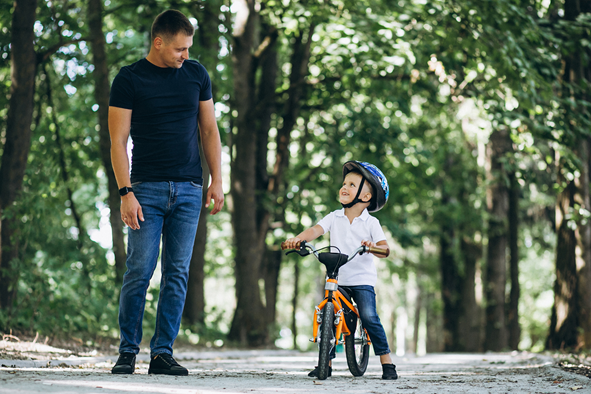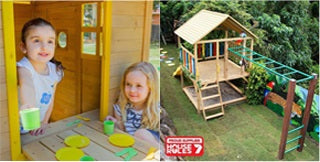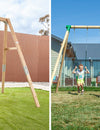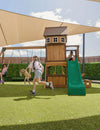The Blog
What Age Can Kids Ride a Bike? A Guide for Parents

Many parents eagerly anticipate the milestone of seeing their kid riding on two wheels. At the same time, it can be hard to know when exactly this milestone should be. Introducing pedal bikes too early may be unsafe, while leaving it too late may risk them falling behind.
In this guide, we’ll explore the ideal age range for learning to ride a bike, factors that influence readiness and tips to help you and your child succeed.
Understanding the Average Age Range
The typical age for children to start learning to ride a bike is between 3 and 7 years old. However, every child is different, and their individual readiness plays a larger role than simply their age. While some children may be ready as young as 3, others may take a bit longer. The most important thing is to focus on their developmental milestones and personal readiness.
Early Starters: Ages 3 to 4

At ages 3 to 4, many children begin with a balance bike. These two-wheeled bikes don’t have pedals, allowing young riders to focus on developing balance and coordination before learning how to pedal. Balance bikes are an excellent tool for toddlers, as they help children build the physical and cognitive skills required for bike riding, such as maintaining balance and steering.
While children at this age might not be ready to ride a pedal bike, using a balance bike can lay the foundation for a smooth transition to a traditional bike.
Typical Learners: Ages 5 to 7
For most children, ages 5 to 7 are when they are ready to start learning on a pedal bike. Many children in this age range can ride without training wheels after some practice, as they have developed the strength and confidence needed for pedalling and steering.
Factors Influencing Readiness
While age is a helpful guideline, several factors play a key role in determining when your child is truly ready to ride a bike. These factors include physical development, emotional readiness and cognitive skills.
Physical Development
A child’s balance, coordination and muscle strength are crucial in determining if they’re ready to ride a bike. A child must be able to sit upright and pedal, as well as maintain balance and steer. If your child shows an interest in physical activities like running, jumping or climbing, they might be ready to tackle bike riding soon.
Emotional Readiness
Aside from physical skills, a child’s confidence and willingness to learn are just as important. Children who are emotionally ready to take on new challenges will feel motivated to learn how to ride. On the other hand, a child who isn’t interested or is scared of falling may not be ready, regardless of their age. Talk with your child and gauge how they feel about riding a bike before making the decision.
Cognitive Skills
Your child must also be able to follow instructions and understand basic safety rules when learning to ride. This includes recognising traffic signs, stopping at intersections and understanding the importance of wearing safety gear like helmets.
Benefits of Learning to Ride a Bike
It’s important to remember that learning to ride a bike offers so much for your child’s development and growth. Here are some of the benefits of learning to ride on two wheels.
Physical Health

Biking improves cardiovascular health, muscle strength and coordination. It’s an excellent full-body workout that enhances leg strength, balance and endurance, making it a fun way to stay active while improving overall health.
Cognitive Development
Learning to ride a bike also stimulates decision-making, problem-solving and focus. It requires kids to pay attention to their surroundings and make quick decisions—skills that benefit them in many other areas of life.
Social Skills

Biking offers great opportunities for social interaction. They can bike around with friends or family and learn new ways to engage with others. Bike rides also provide opportunities for family bonding and exploring the outside world together.
Tips for Teaching Your Child to Ride
Now that you know when your child might be ready, here are some tips to ensure a successful and enjoyable learning experience.
Choosing the Right Equipment

Start by selecting an appropriately sized bike. The right bike should allow your child to touch the ground with their feet while sitting on the saddle. Don't forget to invest in necessary safety gear like a helmet, elbow pads, and knee pads. For more information on safety accessories, check out our range here.
Creating a Supportive Learning Environment
Choose a safe, open area for your child to practice, such as a quiet parking lot, park or driveway. Avoid busy streets or areas with heavy traffic. It’s also important to maintain patience and encouragement—learning to ride can take time, and your child will need your support to stay motivated.
Step-by-Step Teaching Approach
- Balance Training: Start by having your child practice balance on a balance bike or a regular bike without pedals. This helps them develop the basic coordination needed for cycling.
- Pedalling Practice: Once they have mastered balance, introduce pedalling. Encourage your child to pedal while keeping their balance, which can be tricky at first but will come with practice.
- Steering and Braking: Gradually, your child will learn to steer and brake. Practice turning and stopping in a controlled environment so they can master these skills.
Safety Considerations
Importance of Helmets and Protective Gear
Helmets are absolutely essential for protecting your child’s head in case of falls. Also consider adding elbow and knee pads for extra protection while they’re still learning.
Supervision and Setting Boundaries
Supervise your child closely, especially in the early stages of learning. Set clear guidelines for where and when your child can ride, such as specific areas that are free of obstacles. It’s important that they understand the safety rules and always ride under supervision.
Explore Our Range of Children's Bikes

Teaching your child to ride a bike can be an exciting and rewarding experience. By understanding the right age and developmental milestones, preparing them with the right equipment and following safety guidelines, your child will be pedalling confidently in no time.
Ready to get your child started? Explore our range of children’s bikes, designed for various age groups and skill levels. Check out our selection here.














 Shop now, Pay Later
Shop now, Pay Later








